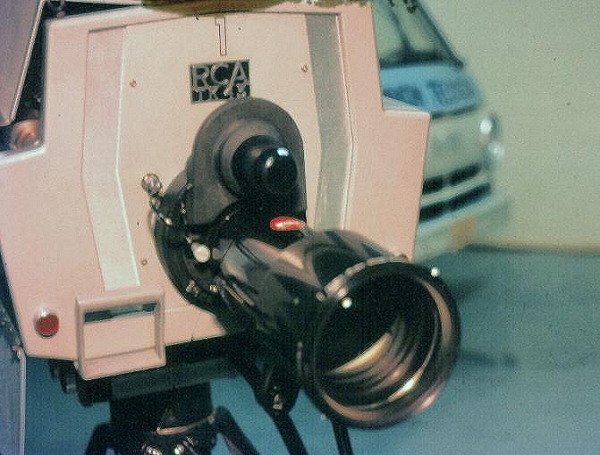In a nutshell, this was RCA’s attempt to stuff a TK60 and a TK41 into one box.
RCA wanted a black-and-white picture as beautiful as the TK60’s and a color picture as good as the TK41C produced. To get the TK60 picture, they used the same 4 ½ inch image orthicon tube, but the color tubes could not be the same 3 ½ inch image orthicons in the TK41, so they used three 1-inch Videocon tubes.

Photo courtesy Lou Bazin and RCA
RCA engineer Lou Bazin is shown working with an engineering lab TK42 above. Lou worked on this and was in on the “off the books” development of what was later the TK44. He also played a big part in the TK45P’s development, as seen below. You can read all of the TK44’s intriguing backstory by clicking here.
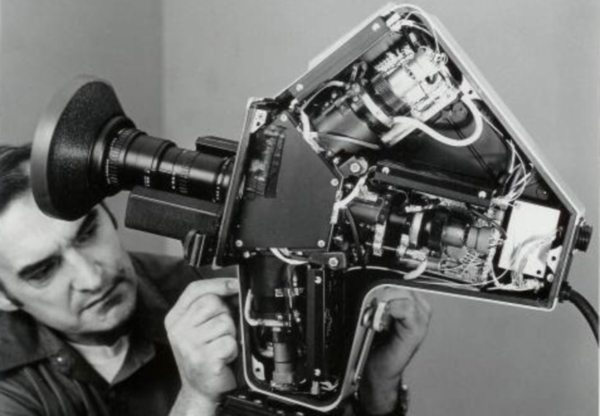
Before I wrote this, I spoke with Lou Bazin (pictured above) who, as a new RCA engineer, worked on this camera design in 1963. Lou said this was their first solid state color project, and they had to make do with the transistors that were available at the time but did manage to finally get good pictures out of the 42 and 43s. By the way, the main difference in the TK42 and the TK43 was the external lens arrangement on the 43. It seems the internal TK42 lens was affected by the camera’s heat and at times would “chatter” while zooming as the lens elements sort of stuck when they were expanded by heat, making a smooth zoom a matter of risk while live.
In the KHVH-TV picture below, you see the TK42 in operation “without a lens,” or so it seems. Again, the lens is inside. I’ve discussed the fact that most of the 42s I see in pictures have a lens on the front and wondered if the internal lens stuck out. Here’s the answer from Lou. The basic lens (without the external adapter) had two selectable focal length ranges (4-20 inches and 8-40 inches) and did not stick out of the camera. RCA offered an aftermarket wide-angle adapter lens though and that gave the camera focal length ranges of 1.6 to 8 inches and from 3.2 to 16 inches, and that’s what we see as “the lens” on the front.

Photo courtesy RCA Broadcast News
From the outside, it looks like the camera above has no lens; TK42s are usually seen with the wide-angle adapter lens, which was an optional piece of gear. Actually, they worked just fine without the adapter but required more camera movement. The TK42 has the 5 to 1 Varatol III zoom lens mounted internally. Below is a one-of-a-kind image from RCA engineer Harry Wright, showing preparations for the first fitting of the lens in the prototype in the Camden design lab. If you look carefully, you can see the lens housing sticking out of the front of the camera and shows how big it really was.
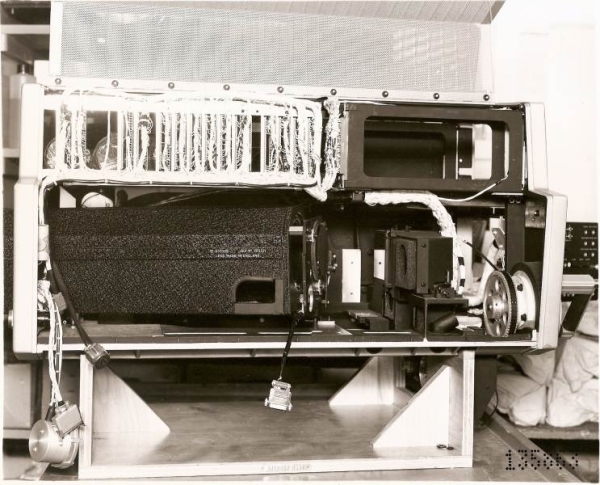
Photo courtesy Harry Wright
By the way…for all of you who ever wondered what “genius” came up with the D-handle zoom and focus controls on the back of the camera, it was Harry Wright. Afterward, Harry was occasionally referred to (in jest) as Harry Wrong. Although ergonomics was the thought behind it, cameramen didn’t go for it. For this one wrong, he can be forgiven, as Harry was one of the most respected mechanical engineers at RCA and his good works are in many RCA innovations. He is especially proud of the TK76, as Harry made major contributions to the development of that pioneering and hugely-successful Electronic News Gathering (ENG) camera.
Just added in the Archives section of this site is a great collection of exclusive documents, photos, schematics and the very first sketches of the TK42 and TK44 from the hand of RCA engineer extraordinaire, my friend Mr. Harry Wright. I am grateful to Harry for his donation of these artifacts to our Archives. To go there, click here.
This lens problem, the camera’s 280-pound weight, and the arrival of the Norelco PC 60 kept this camera from being used by any of the networks, even NBC. But…RCA did bring one of the very first TK43s to NBC at 30 Rock just hours before a big election night event. Unfortunately, the technicians couldn’t get the registration sharp enough to use in time, so they put a logo on it and a cameraman behind it to look like a working camera on the set. Later it was placed in a small “always ready” flash studio for breaking bulletins and late-night news summaries.
Below is one of only two photos known to exist of the now-infamous NBC TK43. The other photo is included in the Harry Wright section of the Archives.
Photo courtesy of Harry Wright.
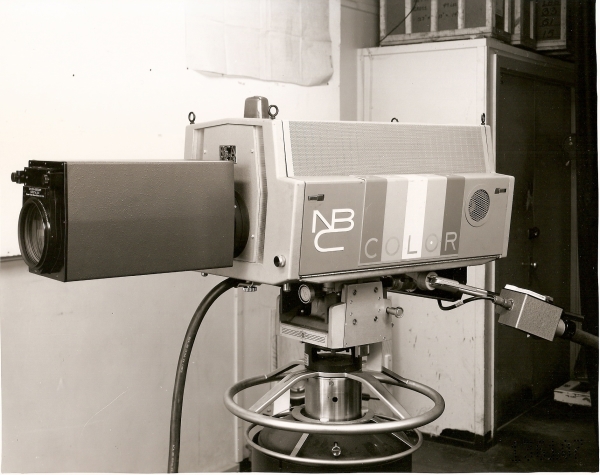
TK42s and 43s were mostly used at local stations. Overall, they did a great job there. WSB-TV in Atlanta was one of the first stations to have the TK42, thanks in large part to The Popeye Club with Officer Don. As the top rated kids show in the country, The Popeye Club was a prime opportunity for RCA to put the cameras in action. At 4 PM weekdays the two WSB TK42s went live for The Popeye Club. Just before 5, one camera was dollied into the news studio next door for an hour of news, to be joined quickly by the second camera.

Photo courtesy Don Kennedy. Many thanks to Officer Don for sharing this.
Above is the only known photo of Atlanta’s famous “Officer Don” Kennedy hosting The Popeye Club in color. In late 1956, the show started as The Clubhouse Gang, and in 1962 became The Popeye Club. Officer Don hosted more than 110,000 kids over those 14 years. As a result of having the highest-rated kids’ show in the nation, RCA approached WSB with two of the first TK42s off the assembly line, asking the station to test them out. This was probably in late 1964. As a personal note, I was on the show in 1958 (at age 8) and 1959 (at age 9), and I thank Don Kennedy for allowing me to use this photo that he took off his wall and scanned just for us.
I am happy to report that in late 2009, one of these huge cameras arrived at my home, completing my RCA camera collection. I now have one each of all the major RCA studio cameras from the TK10 to the TK47. For Christmas 2010, some friends in Canada sent a super-rare wide-angle lens. If you look in my Collection, you’ll see pictures of it.
The cameras you see in the four images below are the first actual working prototypes of the TK42 and TK43. These four pictures, given to me by RCA engineer Harry Wright, were taken in the engineering labs in Camden. As the mechanical engineer on the projects, Harry designed this camera’s appearance. The first sketches of the TK42 are in the Archives section of this site, along with many other pictures that are not duplicated in the Cameras section. Click here to go to the RCA Archives.





Above is a great color shot of a WGAL TK42 with the station’s Barbara Allen. To see over 100 photos of WGAL’s cameras from the early 1950s through the 1970s, visit the WGAL 60 Years of History segment in the Gallery. Those photos are not seen anywhere else on the site, so make sure you take a look! I’m giving you a sneak peek of some of the images here, though, because they are just so good! The three photos just below show an interview with Roy Rogers and Dale Evans, some cooking instruction, and a tour of nuns from 1971. I suspect the nuns are camera operators and directors from one of the large Catholic broadcast centers in Philadelphia or New York.
Photos courtesy WGAL.
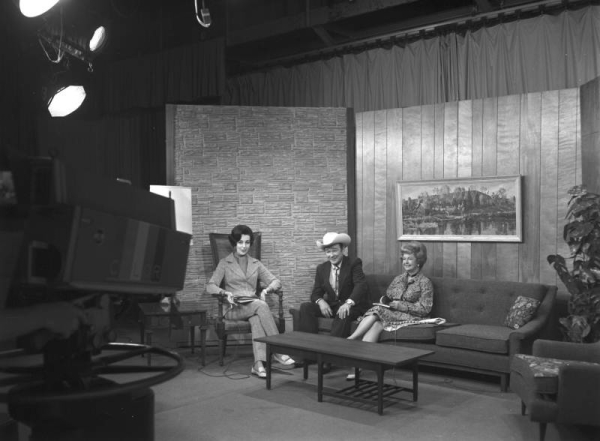
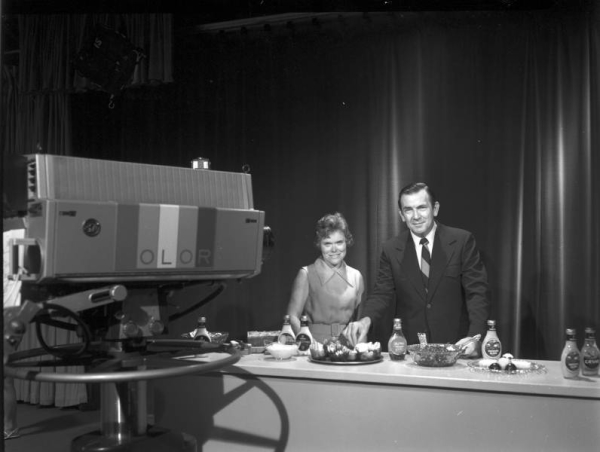

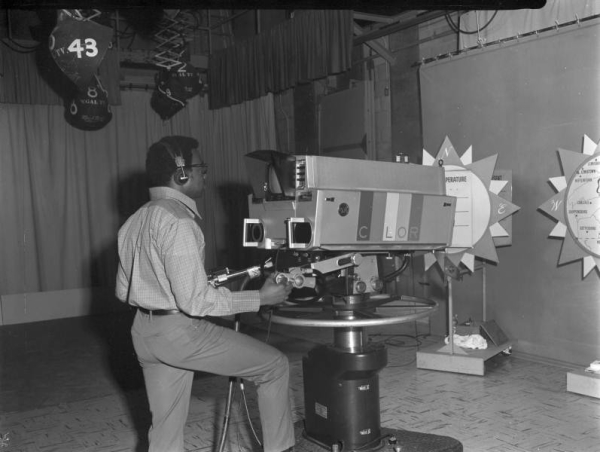
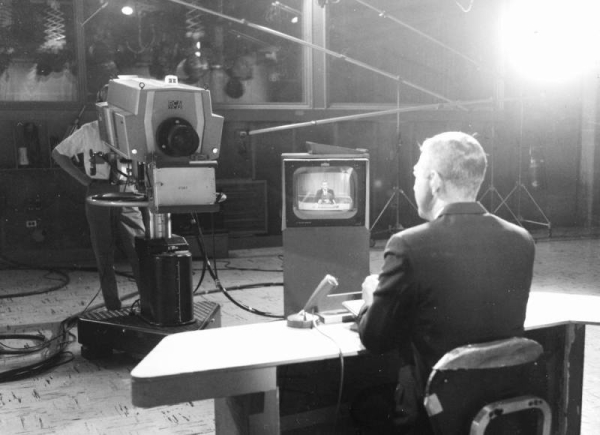
Above and below are WGAL News set photos with TK42s. One of the TD 9 electric pedestals pictured here is now at my house under my TK42.
Photos courtesy WGAL.


Beauties meet the two 280-pound beasts as WGAL goes fashion-forward for Boscov’s department stores. With these TD 9 peds, each camera weighs over 700 pounds.
Photos courtesy WGAL.
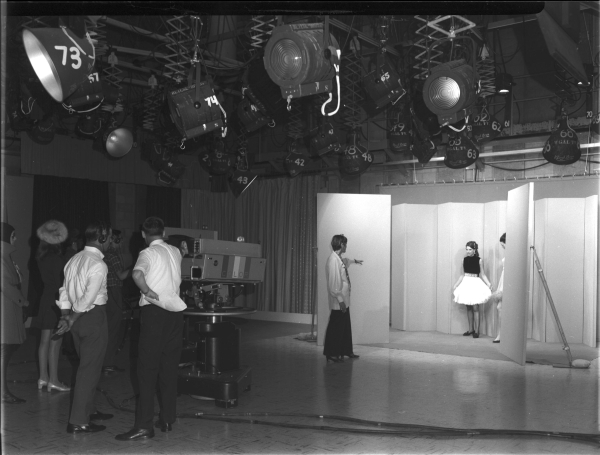
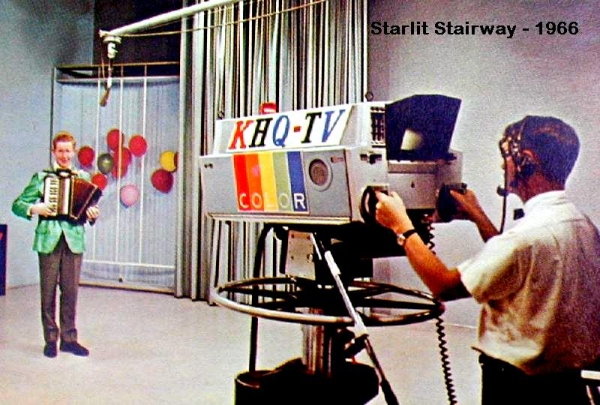
Now, here’s something you don’t see every day…or almost ever. These cameramen at Spokane, Washington’s KHQ are actually using the D handles to zoom and focus! Wonder of wonders.
Photos courtesy Old Radio.com.
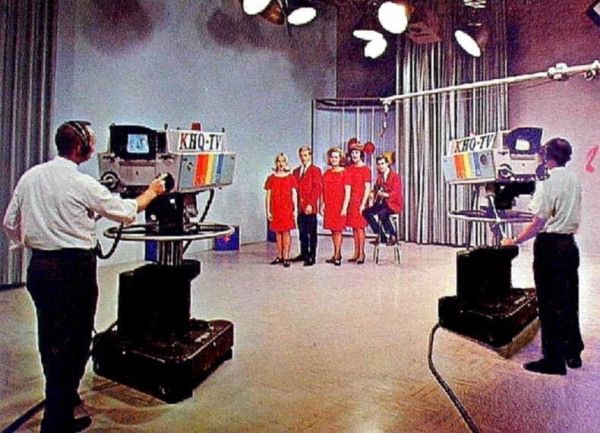
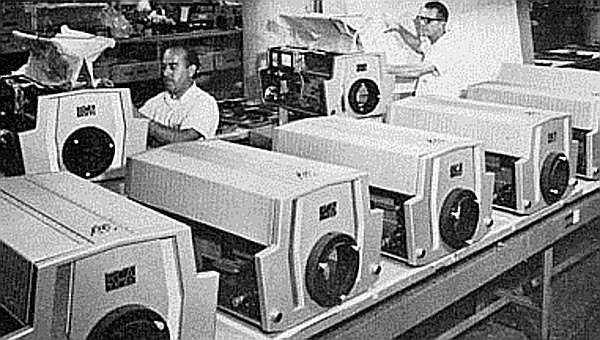
It’s sad to say Camden “ain’t what it used to be,” but this picture reminds us that in its heyday, a great company built great cameras there. Photo courtesy RCA Broadcast News
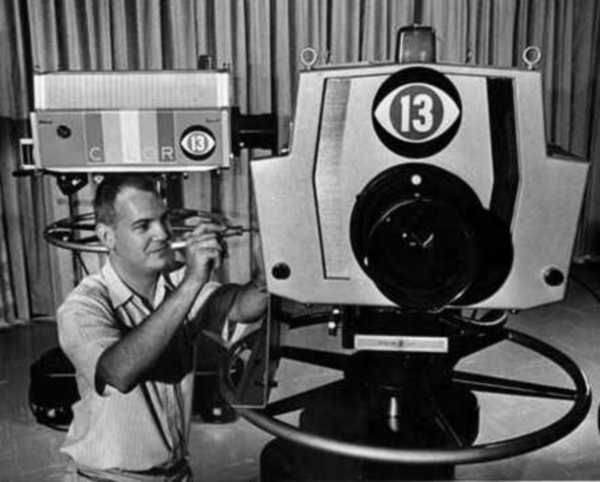
Above, WTVT Tampa engineer Adrian Snow with the station’s TK42s that arrived in April 1966. Notice there are no external zoom or focus controls…yet. Early on they used the D-handles, but as seen in the 1967 color image below and the bottom image from ’68, they eventually abandoned ship on the Ds.
Photos courtesy Mike Clark and big13.net
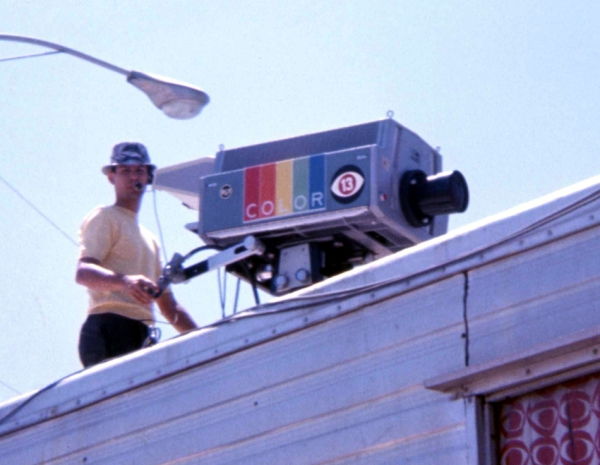
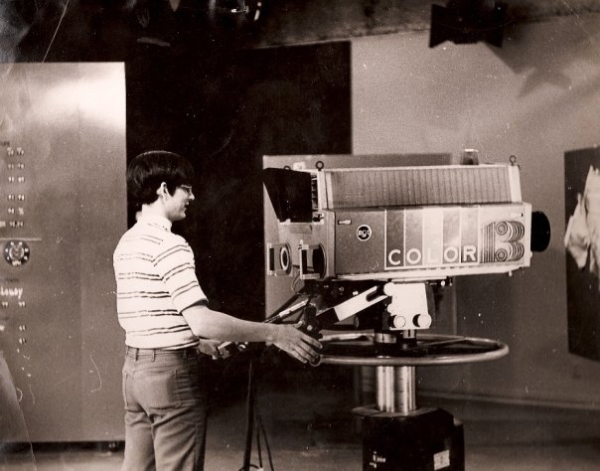
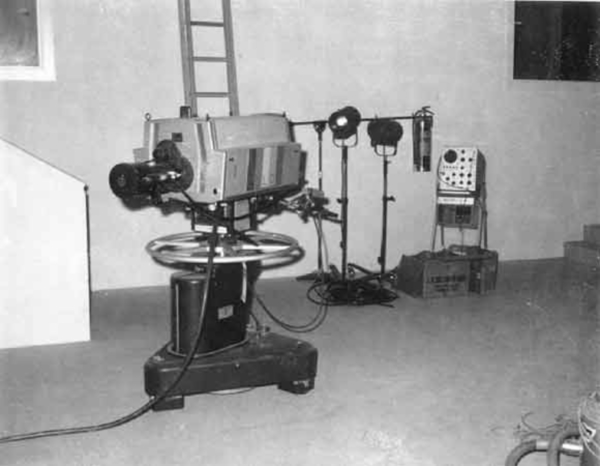
Above is a handsome TK43 sporting its external Taylor-Rank-Hobson Varatol III zoom lens at WJJY, in Jacksonville, Illinois from J. Mitch Hopper; below, WOC-TV cameraman and engineer Jon Book shoots a panel of readings for the evening weather around 1967 in Davenport, Iowa. Photo courtesy captainerniesshowboat.com

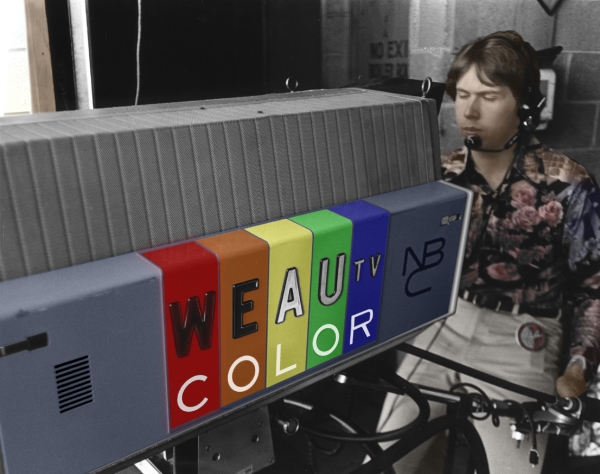
Above and below are photos of one of the newest camera collectors in the US. This is Rick Wold at WEAU in Eau Clair, Wisconsin in his younger days. He’s now the proud owner of an RCA TK41C.


TK42s at Canada’s International Broadcast Center…notice the rare and large Vinten crane.
Photos courtesy RCA Broadcast News.
Below are three more images from Canada’s IBC studios. After these, get ready to go on the road.
Photos courtesy RCA Broadcast News.


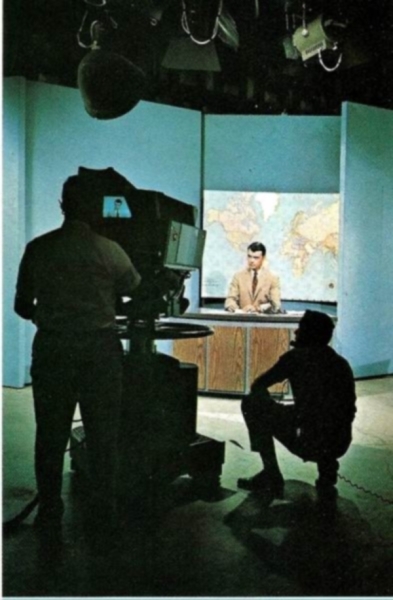
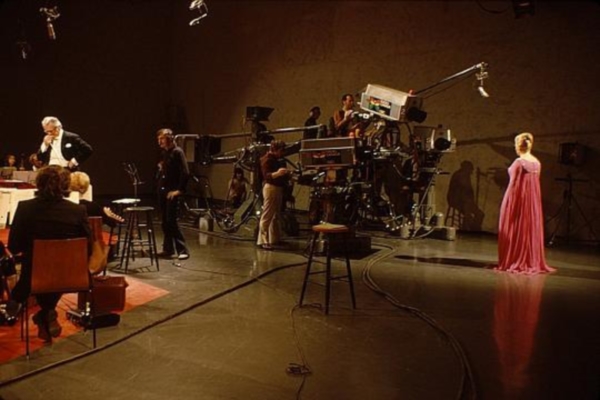
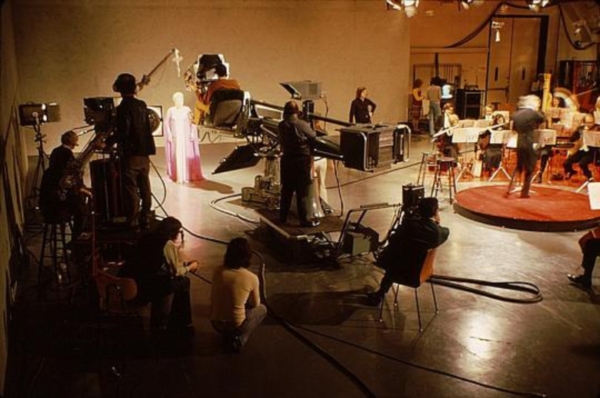
While we are in the IBC studios, above are two great photos taken in 1971 in the main four camera studio. They were sent to me by a man who spent a lot of time there…Serge Bordeleau, who also helped me find the wide angle adapter lens for my TK42. Thank you!
Courtesy of Serge Bordeleua.
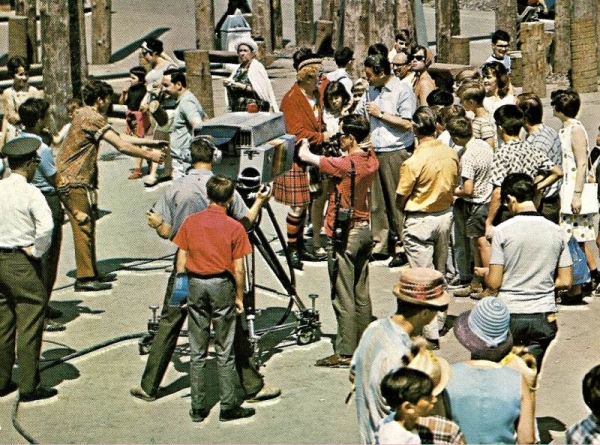
IBC Canada takes TK42s on the road with sports coverage in the photos below. Note that most have a triangular tube structure on top which made a nice waterproof tent when the tarp was applied. NBC’s Fred Himelfarb recommended this in a rare TK42 evaluation memo to RCA that can be seen in the Archives. The tents also worked as a cooling shade in hot weather. I always marvel at the differences between the US and British-made wheeled dollies.
Photos courtesy RCA Broadcast News.
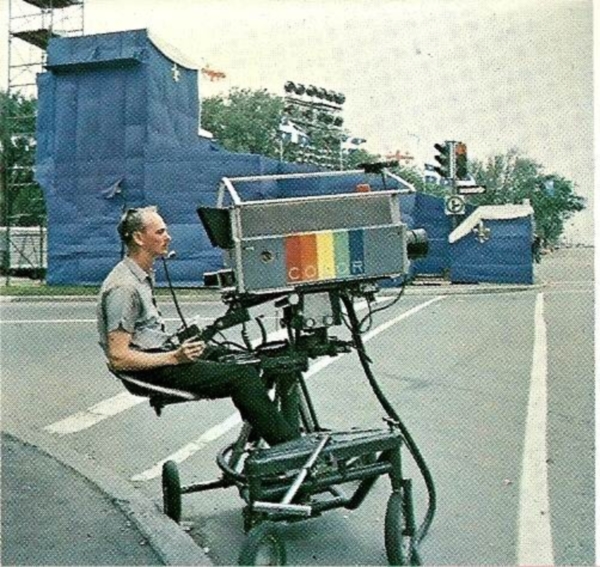
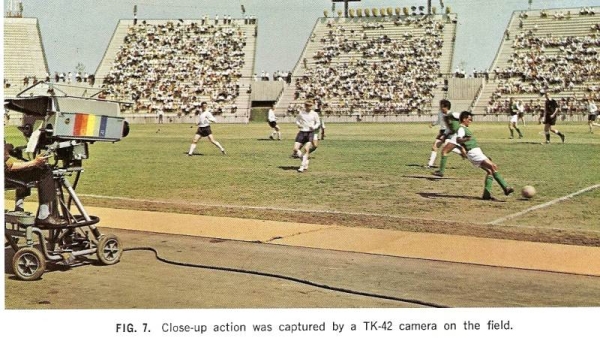
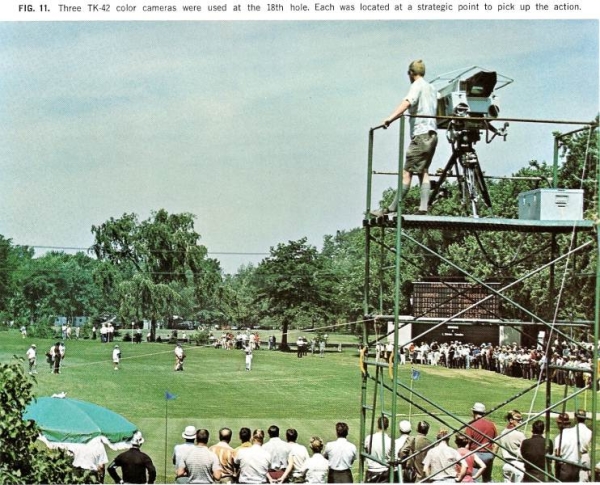

Below are four images from the 1966 NAB Convention showing the RCA TK42 and the new TK43.
Photos courtesy RCA Broadcast News.
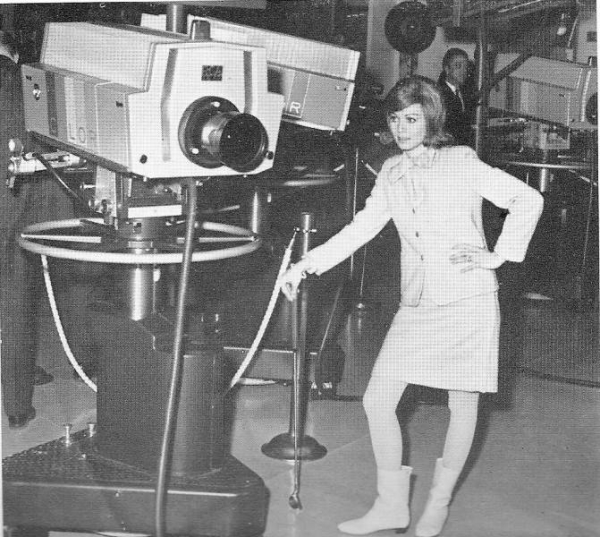


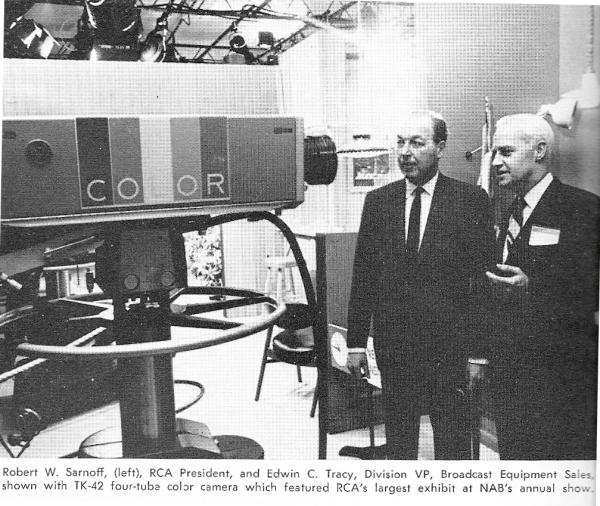
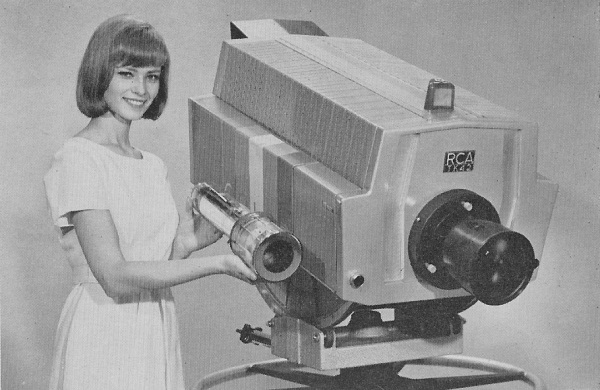
Above and below, three images from the 1965 NAB Show. The TK42 was the RCA item to push, but that lineup still included the TK60, which was still popular. The color-vs.-B&W time was tricky for everyone, and you can read more about that conundrum on the TK60 page.
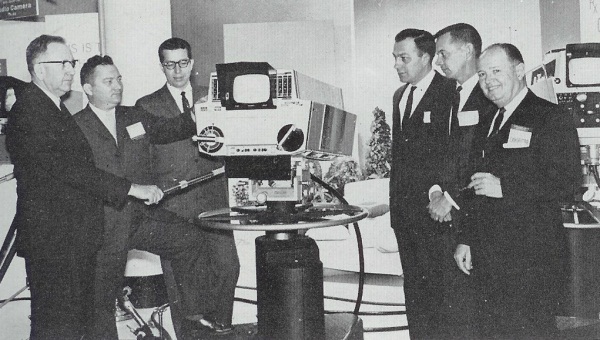
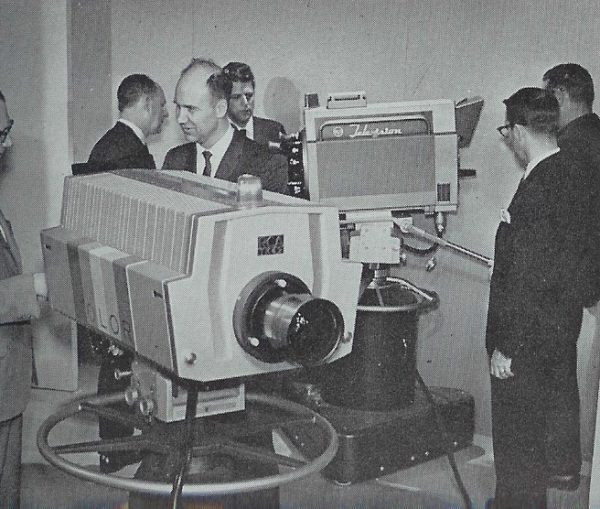
Below are three RCA TK42 ads that appeared in Broadcasting Magazine and RCA Broadcast News around 1965.
Photos courtesy RCA Broadcast News.

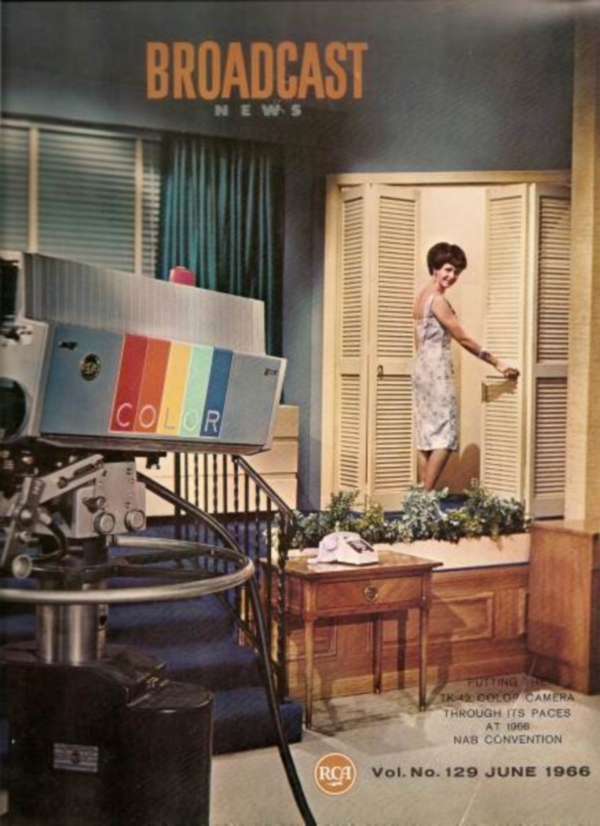
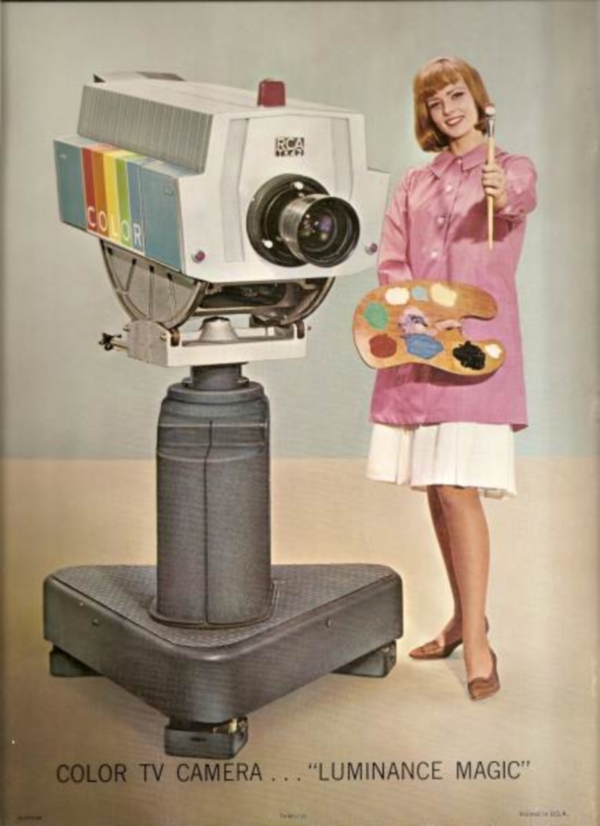


In both 1974 photos above at WYEA-TV in Columbus, Georgia, there is a TK42 on the left and a TK43 on the right.
Dennis Degan Photo
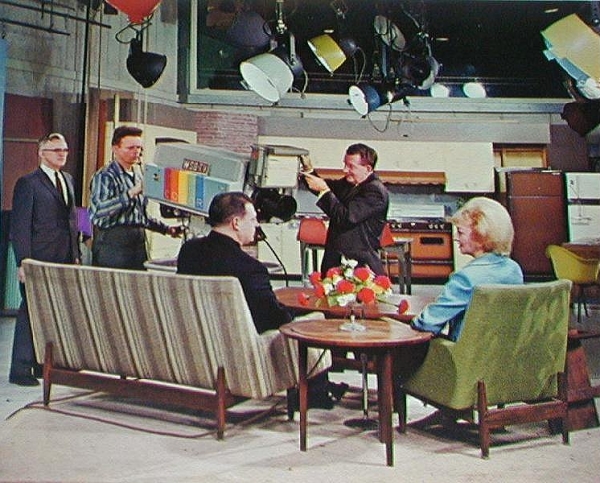
WSB’s Today In Georgia hostess Ruth Kent tapes an interview with WSB director Jerry Johnson while Henry White (C.E.) looks over cameraman Rick Burrell’s shoulder and Pete Peterson works the paper prompter on one of the first TK42s delivered.
All photos below are courtesy of Lytle Hoover’s excellent RCA Collection Section at OldRadio.com
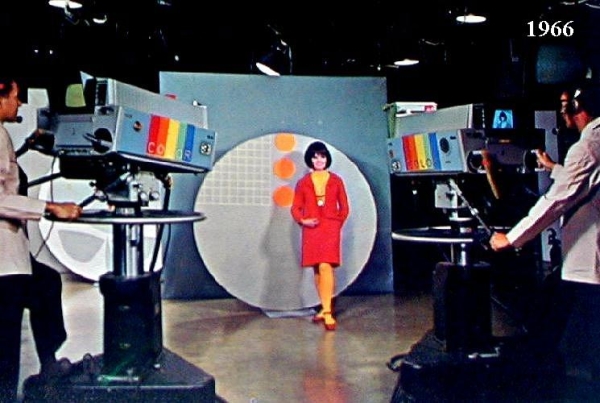


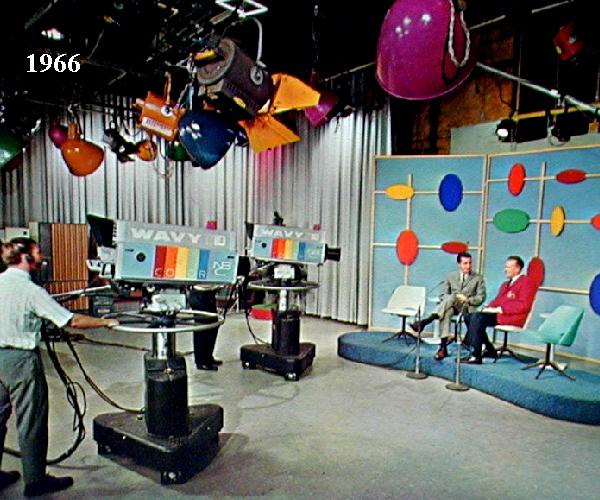
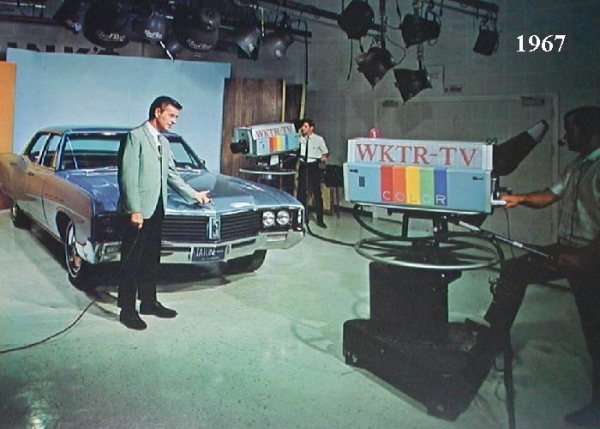


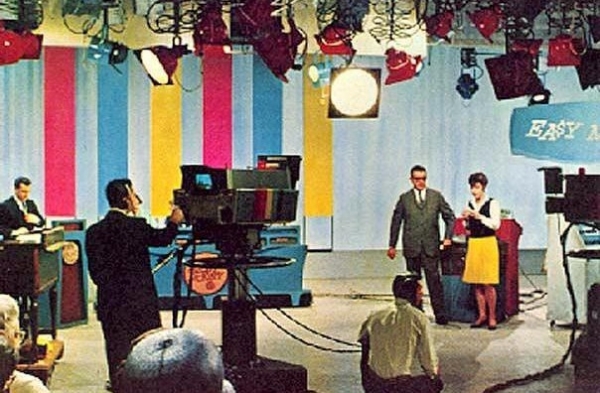

Above and below are TK42s of WHDH-TV, Boston, in the studio, and its TK43s at Fenway Park.
Photos courtesy RCA Broadcast News.
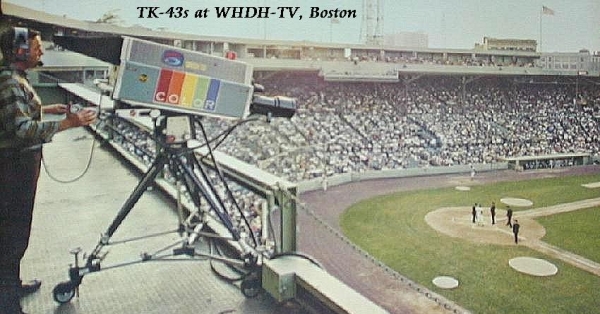
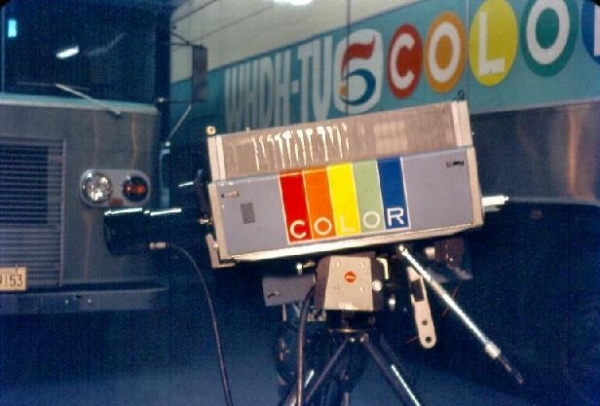
A WHDH TK43 catches its breath after a long day at Fenway. Below, the Rank Taylor Hobson 40 to 400mm zoom. Photos taken in the warm part of 1968.
Photos courtesy Lance D. Kyed
